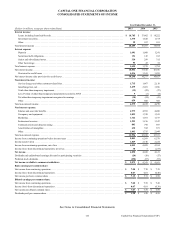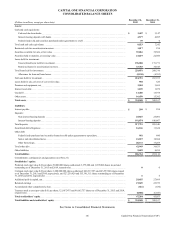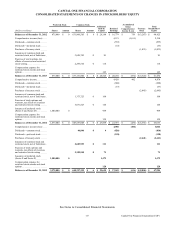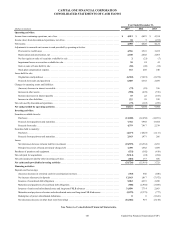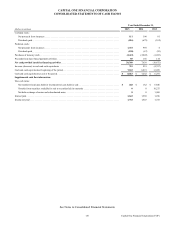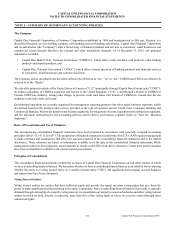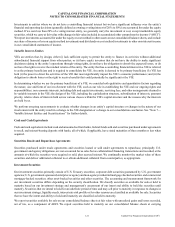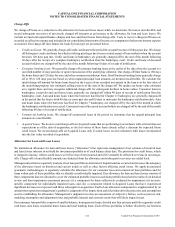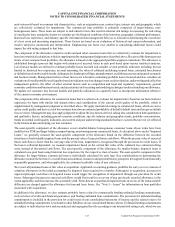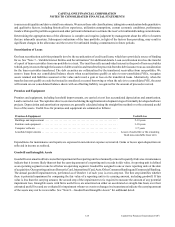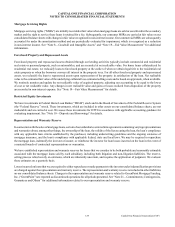Capital One 2015 Annual Report Download - page 140
Download and view the complete annual report
Please find page 140 of the 2015 Capital One annual report below. You can navigate through the pages in the report by either clicking on the pages listed below, or by using the keyword search tool below to find specific information within the annual report.CAPITAL ONE FINANCIAL CORPORATION
NOTES TO CONSOLIDATED FINANCIAL STATEMENTS
121 Capital One Financial Corporation (COF)
Investments in entities where we do not have a controlling financial interest but we have significant influence over the entity’s
financial and operating decisions (generally defined as owning a voting interest of 20% to 50%) are accounted for under the equity
method. If we own less than 20% of a voting interest entity, we generally carry the investment at cost, except marketable equity
securities, which we carry at fair value with changes in fair value included in accumulated other comprehensive income (“AOCI”).
We report investments accounted for under the equity or cost method in other assets on our consolidated balance sheets, and include
our share of income or loss on equity method investments and dividends on cost method investments in other non-interest income
in our consolidated statements of income.
Variable Interest Entities
VIEs are entities that, by design, either (i) lack sufficient equity to permit the entity to finance its activities without additional
subordinated financial support from other parties; or (ii) have equity investors that do not have the ability to make significant
decisions relating to the entity’s operations through voting rights, do not have the obligation to absorb the expected losses, or do
not have the right to receive the residual returns of the entity. The entity that has a controlling financial interest in a VIE is referred
to as the primary beneficiary and is required to consolidate the VIE. An entity is deemed to be primary beneficiary if a VIE has
both (i) the power to direct the activities of the VIE that most significantly impact the VIE’s economic performance; and (ii) the
obligation to absorb losses or the right to receive benefits that could potentially be significant to the VIE.
In determining whether we are the primary beneficiary of a VIE, we consider both qualitative and quantitative factors regarding
the nature, size and form of our involvement with the VIE, such as our role in establishing the VIE and our ongoing rights and
responsibilities; our economic interests, including debt and equity investments, servicing fees, and other arrangements deemed to
be variable interests in the VIE; the design of the VIE, including the capitalization structure, subordination of interests, payment
priority, relative share of interests held across various classes within the VIE’s capital structure and the reasons why the interests
are held by us.
We perform on-going reassessments to evaluate whether changes in an entity’s capital structure or changes in the nature of our
involvement with the entity result in a change to the VIE designation or a change to our consolidation conclusion. See “Note 7—
Variable Interest Entities and Securitizations” for further details.
Cash and Cash Equivalents
Cash and cash equivalents include cash and amounts due from banks, federal funds sold and securities purchased under agreements
to resell, and interest-bearing deposits with banks, all of which, if applicable, have stated maturities of three months or less when
acquired.
Securities Resale and Repurchase Agreements
Securities purchased under resale agreements and securities loaned or sold under agreements to repurchase, principally U.S.
government and agency obligations, are not accounted for as sales but as collateralized financing transactions and recorded at the
amounts at which the securities were acquired or sold, plus accrued interest. We continually monitor the market value of these
securities and deliver additional collateral to or obtain additional collateral from counterparties, as appropriate.
Investment Securities
Our investment securities primarily consist of U.S. Treasury securities; corporate debt securities guaranteed by U.S. government
agencies; U.S. government-sponsored enterprise or agency and non-agency residential mortgage-backed securities and commercial
mortgage-backed securities; other asset-backed securities and other securities. The accounting and measurement framework for
our investment securities differs depending on the security classification. We classify securities as available for sale or held to
maturity based on our investment strategy and management’s assessment of our intent and ability to hold the securities until
maturity. Securities that we intend to hold for an indefinite period of time and may sell prior to maturity in response to changes in
our investment strategy, liquidity needs, interest rate risk profile or for other reasons are classified as available for sale. Securities
that we have the intent and ability to hold until maturity are classified as held to maturity.
We report securities available for sale on our consolidated balance sheets at fair value with unrealized gains and losses recorded,
net of tax, as a component of AOCI. We report securities held to maturity on our consolidated balance sheets at carrying





